

Ancient Judaism (book) Ancient Judaism, also known as Ancient Palestine: Society and Religion (German: Das antike Judentum), is a book written by Max Weber, a German economist and sociologist, in early the 20th century.

The original edition was in German - the essays on Ancient Judaism appeared originally in the 1917–1919 issues of the Archiv fur Sozialwissenschaft und Sozialforschung. Marianne Weber, his wife, published the essays as Part Three of his Gesammelte Aufsatze zur Religionssoziologie' in 1920–1921. An English translation was made in 1952 and several editions were released since then.
Ancient Semitic religion. Ancient Semitic religion encompasses the polytheistic religions of the Semitic speaking peoples of the ancient Near East and Northeast Africa.

Its origins are intertwined with Mesopotamian mythology. As Semitic itself is a rough, categorical term (when referring to cultures, not languages), the definitive bounds of the term "ancient Semitic religion" are only approximate. Proto-Semitic pantheon[edit] Jewish mythology. Jewish mythology is the sacred and traditional narratives that help explain and symbolize Judaism.

Elements of Jewish mythology have had a profound influence on Christian and Islamic mythology, as well as world culture in general. Christian mythology directly inherited many of the narratives from the Jewish people, sharing in common the narratives from the Old Testament. Islamic mythology also shares many of the same stories; for instance, a creation account spaced out over six periods, the legend of Abraham, the stories of Moses and the Israelites, and many more.
Tanakh[edit] Jewish mythology contains similarities to the myths of other Middle Eastern cultures. Introduction to the Old Testament (Hebrew Bible) Judaism. Judaism (from the Latin Iudaismus, derived from the Greek Ἰουδαϊσμός, and ultimately from the Hebrew יהודה, Yehudah, "Judah";[1][2] in Hebrew: יהדות, Yahadut, the distinctive characteristics of the Judean ethnos)[3] is the religion, philosophy and way of life of the Jewish people.[4] Judaism is a monotheistic religion, with the Torah as its foundational text (part of the larger text known as the Tanakh or Hebrew Bible), and supplemental oral tradition represented by later texts such as the Mishnah and the Talmud.
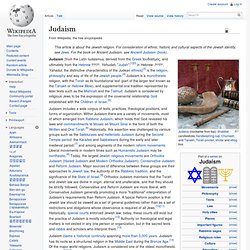
Judaism is considered by religious Jews to be the expression of the covenantal relationship God established with the Children of Israel.[5] Judaism includes a wide corpus of texts, practices, theological positions, and forms of organization. Judaism claims a historical continuity spanning more than 3,000 years. Defining character and principles of faith Defining character Glass platter inscribed with the Hebrew word zokhreinu - remember us Core tenets 13 Principles of Faith: Abraham. Abraham (Hebrew: אַבְרָהָם Abram was called by God to leave his father Terah's house and native land of Mesopotamia in return for a new land, family, and inheritance in Canaan, the promised land.
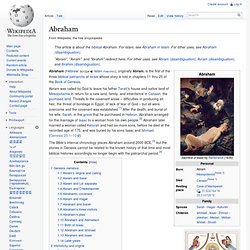
Threats to the covenant arose – difficulties in producing an heir, the threat of bondage in Egypt, of lack of fear of God – but all were overcome and the covenant was established.[1] After the death, and burial of his wife, Sarah, in the grave that he purchased in Hebron, Abraham arranged for the marriage of Isaac to a woman from his own people. Abraham later married a woman called Keturah and had six more sons, before he died at the recorded age of 175, and was buried by his sons Isaac and Ishmael. (Genesis 25:1–10) The Bible's internal chronology places Abraham around 2000 BCE, but the stories in Genesis cannot be related to the known history of that time and most biblical histories accordingly no longer begin with the patriarchal period.
Genesis narrative[edit] Elijah. In Judaism Elijah's name is invoked at the weekly Havdalah ritual that marks the end of Shabbat, and Elijah is invoked in other Jewish customs, among them the Passover seder and the Brit milah (ritual circumcision).
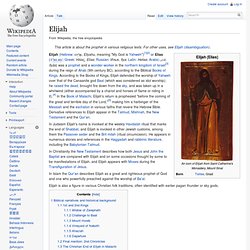
He appears in numerous stories and references in the Haggadah and rabbinic literature, including the Babylonian Talmud. In Christianity the New Testament describes how both Jesus and John the Baptist are compared with Elijah and on some occasions thought by some to be manifestations of Elijah, and Elijah appears with Moses during the Transfiguration of Jesus. In Islam the Qur'an describes Elijah as a great and righteous prophet of God and one who powerfully preached against the worship of Ba'al. Elijah is also a figure in various Christian folk traditions, often identified with earlier pagan thunder or sky gods. Biblical narratives and historical background[edit] Map of Israel as it was in the 9th century BC. As King, Ahab exacerbated these tensions. 1st and 2nd Kings[edit] Biblical Mount Sinai. The approach to Mount Sinai, painting by David Roberts.

Kingdom of Judah. Archaeological record[edit] Mesha Stele c. 850 BCE -An inscribed stone set up c. 840 BCE by Mesha of Moab tells how Chemosh, the God of Moab, had been angry with his people and allowed them to be subjugated to Israel, but at length assisted Mesha to throw off the yoke of Israel and restore the lands of Moab.[5] Significant academic debate exists around the character of the Kingdom of Judah.
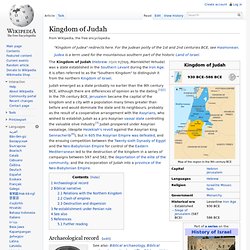
Little archaeological evidence of an extensive, powerful Kingdom of Judah before the late 8th century BCE has been found; Nimrud Tablet K.3751, dated c.733 BCE, is the earliest known record of the name Judah (written in Assyrian cuneiform as Yaudaya or KUR.ia-ú-da-a-a). Moses. Moses (Hebrew: מֹשֶׁה, Modern Moshe Tiberian Mōšéh ISO 259-3 Moše ; Syriac: ܡܘܫܐ Moushe; Arabic: موسى Mūsā ) was, according to the Hebrew Bible, the Qur'an, and Baha'i scripture, a former Egyptian prince and warrior,[citation needed] later turned religious leader, lawgiver, and prophet, to whom the authorship of the Torah is traditionally attributed.
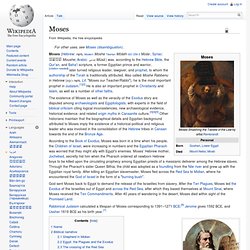
Also called Moshe Rabbenu in Hebrew (מֹשֶׁה רַבֵּנוּ, Lit. "Moses our Teacher/Rabbi"), he is the most important prophet in Judaism.[1][2] He is also an important prophet in Christianity and Islam, as well as a number of other faiths. Mount Horeb. Moses with tablets of the Ten Commandments, painting by Rembrandt, (1659) Mount Horeb, Hebrew: חֹרֵב, Greek in the Septuagint: χωρηβ, Latin in the Vulgate: Horeb, is the mountain at which the book of Deuteronomy in the Hebrew Bible states that the Ten Commandments were given to Moses by God.
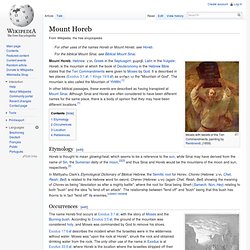
It is described in two places (Exodus 3:1, 1 Kings 19:8) as הַר הָאֱלֹהִים the "Mountain of God".
Torah. Torah (/ˈtɔːrə/; Hebrew: תּוֹרָה, "Instruction, Teaching"), or what is often referred to in English as "Pentateuch" (/ˈpɛntəˌtuːk, -ˌtjuːk/), is the central concept in the religious Judaic tradition. It has a range of meanings: it can most specifically mean the first five books of the twenty-four books of the Tanakh; it usually includes the rabbinic commentaries in it; the term Torah means instruction and offers a way of life for those who follow it; it can mean the continued narrative from Genesis to the end of the Tanakh; it can even mean the totality of Jewish teaching, culture and practice.[1] Common to all these meanings, Torah consists of the foundational narrative of the Jewish people: their call into being by God, their trials and tribulations, and their covenant with their God, which involves following a way of life embodied in a set of moral and religious obligations and civil laws (halakha).
Meaning and names[edit] Torah as Pentateuch[edit] Nevi'im. Nevi'im[pronunciation?] (Hebrew: נְבִיאִים Nəḇî'îm, "Prophets") is the second main division of the Hebrew Bible (the Tanakh), between the Torah (instruction) and Ketuvim (writings). It contains two sub-groups, the Former Prophets (Nevi'im Rishonim נביאים ראשונים, the narrative books of Joshua, Judges, Samuel and Kings) and the Latter Prophets (Nevi'im Aharonim נביאים אחרונים, the books of Isaiah, Jeremiah and Ezekiel and the Twelve Minor Prophets). Many of the writings of the Latter Prophets are thought by scholars to be older than the narratives of the Former Prophets which precede them in the canon, and were profoundly influential on the direction and development of Hebrew religion. The Latter Prophets have also had a wide influence on literature and on political and social activism in cultures outside of Judaism.
Synopsis[edit] In Judaism, Samuel and Kings are each counted as one book. Former Prophets[edit] Joshua[edit] Ketuvim. Ketuvim[pronunciation?] (in Biblical Hebrew: כְּתוּבִים Kəṯûḇîm, "writings") is the third and final section of the Tanakh (Hebrew Bible), after Torah (instruction) and Nevi'im (prophets). In English translations of the Hebrew Bible, this section is usually entitled "Writings" or "Hagiographa".[1] The Ketuvim are believed to have been written under the Ruach HaKodesh, but with one level less authority than that of prophecy.[2]
Oral Torah. According to Rabbinic Judaism, the "Oral Torah" or "Oral Law" (Hebrew: תורה שבעל פה, Torah she-be-`al peh, lit "Torah that is spoken") represents those laws, statutes, and legal interpretations that were not recorded in the Five Books of Moses, the "Written Torah" (Hebrew: תורה שבכתב, Torah she-bi-khtav, lit.
"Torah that is written"), but nonetheless are regarded by Jews as prescriptive and co-given. This holistic Jewish code of conduct encompass a wide swath of ritual, worship, God-man and interpersonal relationships, from dietary laws to Sabbath and festival observance to marital relations, agricultural practices, and civil claims and damages. According to Jewish tradition, the Oral Torah was passed down orally in an unbroken chain from generation to generation until its contents were finally committed to writing following the destruction of the Second Temple in 70 CE, when Jewish civilization was faced with an existential threat.[1] Mitzvah. In its primary meaning, the Hebrew word mitzvah ("commandment", מִצְוָה, [mit͡sˈva], Biblical: miṣwah; plural מִצְווֹת mitzvot [mit͡sˈvot], Biblical: miṣwoth; from צִוָּה ṣiwwah "command") refers to precepts and commandments as commanded by God.
It is a word used in Judaism to refer to the 613 commandments given in the Torah (at Mount Sinai, where all the Jews accepted the Torah, saying "We will do, and we will listen") and the seven rabbinic commandments instituted later for a total of 620. According to the teachings of Judaism, all moral laws are, or are derived from, divine commandments.
In its secondary meaning, Hebrew mitzvah, as with English "commandment," refers to a moral deed performed as a religious duty. As such, the term mitzvah has also come to express an act of human kindness. 613 commandments. Jewish religious movements. Jewish religious movements sometimes called "denominations" or "branches", include different groups which have developed among Jews from ancient times and especially in the modern era among Ashkenazi Jews living in anglophone countries. Hasidic Judaism. Hasidic Judaism from the Hebrew: חסידות (Sephardic pronunciation: IPA: [ħasiˈdut]; Ashkenazic pronunciation: IPA: [χaˈsidus]), meaning "piety" (or "loving-kindness"), is a branch of Orthodox Judaism that promotes spirituality through the popularization and internalization of Jewish mysticism as the fundamental aspect of the faith.
It was founded in 18th-century Eastern Europe by Rabbi Israel Baal Shem Tov as a reaction against overly legalistic Judaism. Zohar. Velveteen Rabbi. Qabala (Kaballah) KABBALAH.